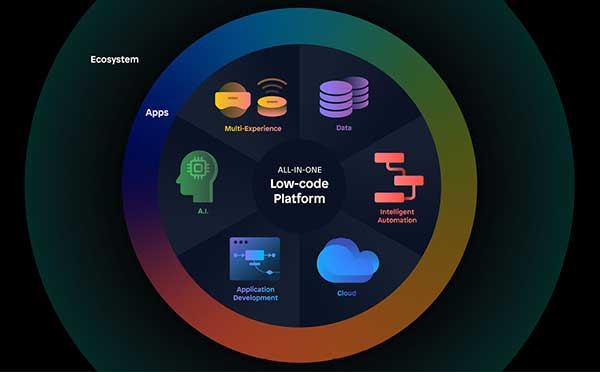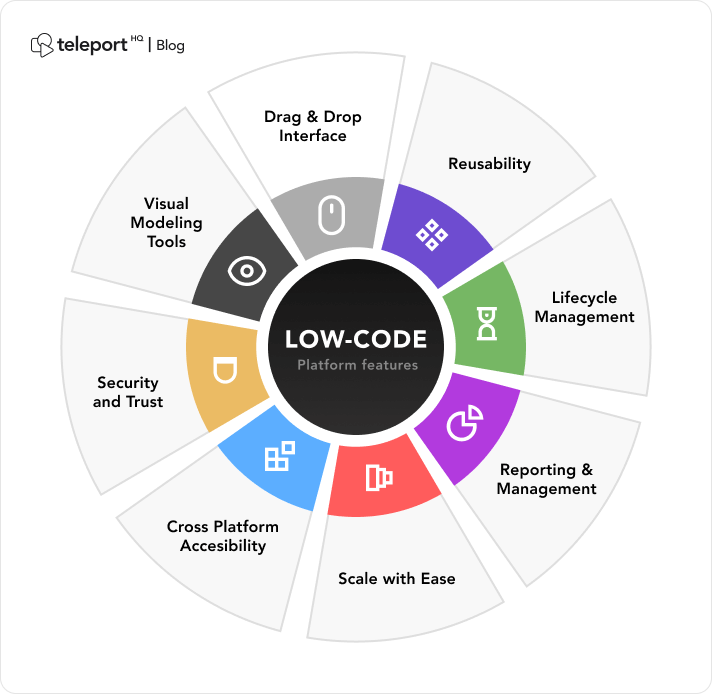Handy Info For Choosing Low-Code Platform Recommendations
Handy Info For Choosing Low-Code Platform Recommendations
Blog Article
In Regards To Integration Capabilities Low-Code Applications Development Has Many Advantages.
Low-code development of apps has numerous advantages, specifically in terms of integration. This is essential in creating apps that seamlessly connect with systems and other services. Here are a few of the principal benefits that come with APIs and connectors that are pre-built.
A Wide Variety of Connectors The Low-code platforms typically come with an array of connectors that are pre-built for popular enterprise software (e.g. databases, CRMs, ERPs, cloud services). The integration process is simplified.
API Integration - Many low-code platforms come with API integration, which gives developers easy access to other data sources or external services.
User-friendly:
Drag-and–Drop Integration Integrations can be implemented with drag and drop interfaces. Developers and non-developers are able to do this without having to write lengthy code.
Visual Workflow Builders : Software to create workflows and data flow that are visualized help learn and configure integrations in a more intuitive method.
Standardized Integration Methods:
SOAP and RESTful Services Support for standard web services protocols such as SOAP and REST allows straightforward integration with a wide range of other software and systems.
OData Standards: OData standards allow for easy manipulation and accessibility of data across different platforms and apps.
Real-Time Data Synchronization:
Real-Time Integrations: Low-code platforms can handle real-time data sync between systems and applications. This guarantees that information is current and synchronized across the company.
Event-Driven architecture: Some platforms support event driven architectures. This allows apps to respond to events in real-time, which is essential for interactive and dynamic apps.
Legacy System Integration:
Low-code platforms: These can be used to connect old systems to modern systems. They're a great method to modernize your IT infrastructure, without having to overhaul everything.
Data Migration Tools: These built-in tools for data migration facilitate the transfer from old systems to new applications built using low-code platforms.
Integration of Third-Party Services:
Cloud Services: Seamless Integration with Cloud Services such as AWS Azure Google Cloud and Google Cloud enables easy deployment of applications.
Business Applications Integration Lowcode platforms are utilized to connect various business applications like Salesforce, SAP, Microsoft Dynamics etc. to create a seamless workflow among different business functions.
Simplified Data management:
Unified Data Models: A few low-code platforms provide unified data models that simplify data management and integration across multiple systems.
Data Connectors - Connectors pre-configured to allow for quick access to, and manipulation of data from a variety of sources.
Security and Compliance
Secure Integrations: Low-code platforms guarantee that integrations adhere to security protocols as well as standard security standards, securing data in transportation as well as during rest.
Security Features: These platform usually have features to make sure that integrations comply with regulatory requirements, such as GDPR or HIPAA. This gives peace ofmind for businesses handling sensitive information.
Extensibility:
Low-code platforms are able to accommodate complex integration needs by including custom code or scripts. They allow for flexibility without compromising their accessibility.
Plug-in Ecosystems. A network of plug-ins and extensions will allow you to enhance your integration abilities, adding new functionalities whenever needed.
Low-code platforms are a powerful instrument to create interconnected robust and scalable applications. They facilitate the process of connecting different systems, improve the flow of data and enable enterprises to embrace new technologies while leveraging existing ones. See the top rated Low-code Platform for application development for more recommendations including database in azure, rapid applications, push alerts, cross platform app development, develop web app, application modernization, application modernisation, application modernisation, develop mobile application, application modernization software and more.
Benefits Of Low-Code Application Development In Terms Of Flexibility And Scalability
Low-code development of applications offers a variety of advantages regarding adaptability and scalability, which are vital to build applications that expand with the needs of businesses and change with the demands of business. Here are a few major advantages: Rapid scaling:
Cloud-Based Deployment: Many low-code platforms use cloud technology that allow applications to scale seamlessly with the underlying cloud infrastructure. This enables businesses to manage the increased workload without worrying about managing servers.
Auto-Scaling: The auto-scaling function will automatically adjust the resources according to the demands. This will ensure consistent performance at peak times, without any manual intervention.
Flexible Architecture:
Modular Application Design: A low-code platform encourages modular design of applications. Components can be independent evaluated, designed and expanded. This flexibility increases flexibility and allows to update or expand specific elements of a program without affecting the entire system.
Microservices Integrate: Microservices allow applications to expand and be flexible because they can be constructed as a group of services that are loosely connected.
Customizable Solution:
Flexibility : Low-code platforms allow developers to expand capabilities beyond what is available in standard features. This enables unique business requirements to be fulfilled without limitations.
Third-Party Integrations: Businesses are able to integrate additional functionality and features into their applications by integrating APIs and third-party providers.
Agile Development and deployment
Continuous Delivery and Deployment : Low-code platforms can support agile methodologies enabling continuous integration, continuous delivery (CI/CD). This lets applications be updated and upgraded swiftly as a result of feedback from users.
Iterative Design: Because low-code is an iterative procedure it is possible to incrementally improved and then scaled up. This permits gradual growth and decreases the risks of large-scale modifications.
Resource Optimization
Effective Resource management: Platform tools that use low-code aid in optimizing resource usage by monitoring and managing performance of the applications. This lets resources be used efficiently, and also to be scaled down or up based on the actual need.
Load-balancing features that distribute workloads equally across servers improve the ability of an application to handle large volumes of traffic and ensure consistent performance.
Global Reach
Multi-Region Accessibility: Lowcode platforms allow to be used across a variety of regions. Businesses can provide users low-latency worldwide access. This is vital when it comes to applications that target a global audience.
Support for Localization. Inbuilt support for localizing applications lets them be easily adapted to different local languages, regional needs and increases their flexibility across various markets.
Updates and maintenance
Maintenance is made easier because of the modularity and appearance of low-code apps simplifies maintenance, allowing for quick update and bug fixes to be implemented without lengthy downtime.
Version Control: Integrated version control systems handle rollbacks and changes to ensure that updates are able to be made and that older versions can be restored if needed.
Cost Efficiency:
Low Development Costs: By cutting down on the amount of code required, low code platforms can lower development costs. This allows to scale up applications without needing to increase development efforts and expenses.
Pay-As you Go Models Numerous platforms that are low-code provide flexible pricing options, such a pay-as we-go models that align costs and usage with the actual growth.
Low-code development gives businesses a number of advantages, such as scalability, flexibility and ad-hoc adaptability. This allows them to develop robust, flexible and scalable apps. These platforms allow for rapid adjustments to meet changing requirements as well as efficient utilization of resources and constant improvement, which ensures that the application can develop and grow to meet the needs of the business. Read the top rated additional reading for Enterprise application development with Low-code Platform for site advice including lowcode no code, jdbc server, develop cross platform mobile app, develop mobile application, build a docker container, mobile app development platforms, develop web application, app dev platform, database in azure, ms azure sql and more.
Benefits Of Low-Code App Development In Terms Of Limitations And Customization
Low-code development offers an approach that is balanced to address limitations, while also allowing for customization. Here are some of the major advantages: Handling limitations
: .
Low-code platforms make development easier by providing pre-built templates and other components. This facilitates quicker deployment and the development of more complex applications.
Guided Workflows: A lot of platforms have guided workflows as well as wizards to help developers navigate through complicated processes, reducing the chance of making mistakes and ensuring consistency.
Scalability Solutions:
Built-in Scalability: Low-code systems usually have features that support the development of scalable architectures, which allows applications to handle higher load without requiring significant changes.
Performance Monitoring: Integrating instruments for monitoring performance optimization, tuning and monitoring aid in ensuring that applications are scaled efficiently.
Security and Compliance
Integrated security features: Low-code platforms have security measures like encryption and access control based on role and automated compliance monitoring that address the most common security concerns.
Platforms frequently update their security and compliance procedures to ensure that applications are safe from new threats.
Customization Features:
Extensibility:
Low-code Platforms Allow Custom Code: These platforms allow for the integration and the use of custom code.
Customized plugins and modules Developers can design customized plugins or modules that include specific functions that are tailored to unique business requirements.
APIs and Integration
API Support: The extensive support for APIs allows seamless integration with other systems and services, which allows for customizing and connectivity.
Third-Party Service: Low-code platforms provide pre-built connectors to well-known third-party service providers. This makes it simple to integrate and customize applications.
Designing UI/UX that is flexible:
Customizable Interfaces Developers are able to create and alter user interfaces based on specific branding and usability requirements, resulting in a customized user experience.
Responsive design: The capacity to customize applications for different devices and screens is built-in.
Custom Business Logic for Businesses:
Visual Workflow Builders: Visual tools used to build and modify workflows. business logic and procedures allow developers to develop intricate and custom processes with no the need for programming.
Platforms include conditional Logic that allows the development of custom scripts that address specific scenarios and business rules.
Data Management:
Custom Data Modelling: Developers define custom models to fit specific application needs. They can customize data handling to the business's requirements.
Advanced Data Processing: The integration of advanced tools and capabilities for data processing allows customizations in the way data is analyzed in an application.
How do you balance personalisation and limitations:
Frameworks and Standards:
Best Practices: Low-code platform encourages compliance with standards and industry best practices. This can be helpful in maintaining high quality secure, scalable, and scalable applications.
Governance Frameworks: Built-in governance frameworks ensure that customizations do not affect the security, integrity or the compliance of the application.
Iterative Development and Feedback
Rapid prototyping: Developers are able to quickly prototype and test customizations based on the feedback of users, enhancing the application according to their requirements.
Continuous Improvement: Platforms that use low-code support continuous improvements which allow for customization and improvement as business needs evolve.
Users Empowerment
Giving Citizen developers the tools they need: The low-code interfaces that are intuitive allow non-developers to create customisations. This can increase the number of contributors able to improve and customize applications.
Support and Training: A lot of platforms provide extensive training and support that can assist users with making efficient customizations without compromising stability or performance.
Overall, low-code application development provides a solid framework to overcome limitations while providing ample opportunities for customization. This balance ensures businesses can create and maintain apps that are both tailored and functional to meet their particular requirements while maintaining the highest standards of security, quality, and the ability to scale.